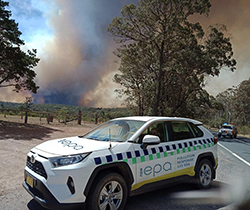EPA builds environmental resilience
The EPA is increasingly called on to respond to emergencies rapidly and often followed by prolonged periods of recovery.

The EPA is planning for as well as responding to incidents which impact the environment
The 2019/20 bushfires, the March 2021 floods and COVID-19 pandemic have propelled our teams to build our resilience. Responding to emergencies and extreme weather events is a key area of our recently released Strategic Plan. We aim to not only respond and recover, but to plan, prepare for and prevent, where we can, future challenges affecting the environment and our communities.
In tackling this challenge, we have identified the need to equip ourselves and our communities with the tools needed to manage both anticipated and unexpected events.
“The EPA plays a key role in disaster response and recovery and maintains strong partnerships with other key agencies such as Fire and Rescue NSW and Resilience NSW,” EPA Executive Director Regulatory Operations Stephen Beaman said.
“We are increasing our expertise in environmental disaster management and recovery through synchronised planning between our programs like bushfire recovery, and operations on the ground,” he said.
“As part of our current flood clean-up work – ongoing from the March floods, we are coordinating with other NSW government agencies including Crown Lands and National Parks, and I am fortunate to Chair the state’s Waste and Environment Sub-Committee.
“We now want to develop a stronger strategic platform to focus on how we can better prepare for and even prevent the impacts of future events, such as from severe weather, and not just respond and recover.
“Our commitment is about working hard to mitigate against the effects of climate change – a key focus in our new Strategic Plan, and to be ‘season ready’.
“We are building on lessons learned and looking at where else we can apply our expert knowledge and advice, from our work during fires and floods, assessing for risks such as asbestos after emergencies, managing clean-ups and helping to keep communities safe.
“During this pandemic, we have had to act quickly to help operators manage waste services under the restrictions, and we are looking to take these learnings to create a handbook for the future.
“We want to be prepared, we want in-built resilience.”
The EPA is looking to build up an environmental resilience plan, working with the NSW Government’s lead agency Resilience NSW over coming months “We want to create a guidance toolkit which can benefit our partners, local councils, Aboriginal land councils and other public land managers,” Stephen added.
“We want to hard-wire our protection of the environment as far as possible.”
Environmental resilience is a term now embedded in the objectives of the United States Environmental Protection Agency. The US agency describes environmental resilience as “minimizing environmental risks associated with disasters, quickly returning critical environmental and ecological services to functionality after a disaster while applying this learning process to reduce vulnerabilities and risks to future incidents.”
In this edition of EPA Connect we also:
- explore some regional case studies of successful operations during COVID-19 including virtual compliance checks
- provide tips to help our licensees and the community to prepare for severe weather expected this spring and summer
- Share our expertise and actions on air quality including seasonal issues such as increased dust

